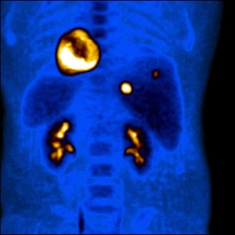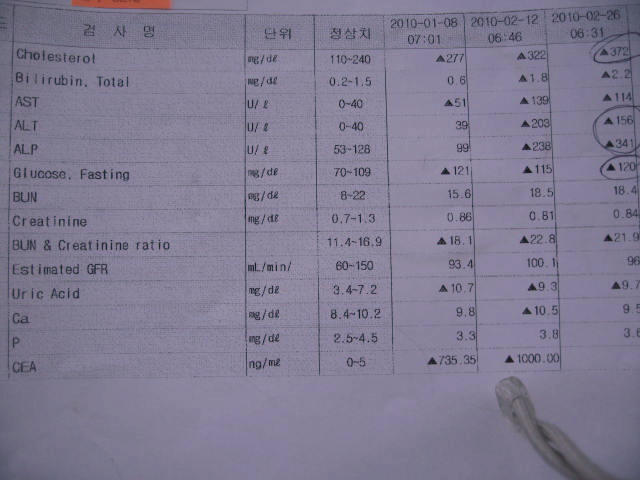 CEA (carcinoembryonic antigen) is a type of protein molecule that can be found in many different cells of the body, but is typically associated with certain tumors and the developing fetus. The most frequent cancer which causes an increased CEA is cancer of the colon and rectum. CEA is most frequently tested in blood. It can also be tested in body fluids and in biopsy tissue. The best use of CEA is as a tumor marker, especially for cancers of the gastrointestinal tract. When the CEA level is abnormally high before surgery or other treatment, it is expected to fall to normal following successful surgery to remove all of the cancer. A rising CEA level indicates progression or recurrence of the cancer. In addition, levels >20 ng/ml before therapy are associated with cancer which has already spread (metastatic disease).
CEA (carcinoembryonic antigen) is a type of protein molecule that can be found in many different cells of the body, but is typically associated with certain tumors and the developing fetus. The most frequent cancer which causes an increased CEA is cancer of the colon and rectum. CEA is most frequently tested in blood. It can also be tested in body fluids and in biopsy tissue. The best use of CEA is as a tumor marker, especially for cancers of the gastrointestinal tract. When the CEA level is abnormally high before surgery or other treatment, it is expected to fall to normal following successful surgery to remove all of the cancer. A rising CEA level indicates progression or recurrence of the cancer. In addition, levels >20 ng/ml before therapy are associated with cancer which has already spread (metastatic disease).
The following is the story of 52 yr old male patient with terminal stage colon cancer. He is South Korean. In Feb 2008, he was diagnosed as having stage4 colon cancer. In March 2008, he had colon surgery and had chemo for many months. In Sep 2008, he had radiation Tomotheraphy treatment. However, in Oct 2008, CT scan showed multiple metastases in his lungs. After several surgeries due to complications he was left with a colostomy bag. In March 2009, he got the results from the CT scan and blood test. His colon cancer has spread to his liver, and the tumor marker CEA level was elevated to 534 ng/ml from 21 ng/ml. In this patient, the serum CEA level is a highly sensitive marker of colon cancer.
Doctors will refer to it as mets, secondary or metastatic tumors from the original colon tumor. Both of these organs are common places for colon cancer to spread.
He underwent several months of chemo again using different types of drugs. After completion of the chemo, the serum CEA level decreased and CT scan of the chest revealed marked reductions of the tumor in the lungs and in the lymph node metastasis. In Oct 2009, he had colostomy reversal surgery and finally the large intestine (colon) and rectum were reconnected. However, in Jan 2010, cancer cells developed a resistance to drugs. CEA level had risen sharply to 735.35 ng/ml, and then 1,000 ng/ml in Feb 2010. His doctor detected jaundice and further tests revealed that the cancer has progressed throughout his liver and lungs. There was nothing more they can do.
Feb 27, 2010, we got his blood test results and found out his cholesterol level was abnormally elevated. Liver enzymes AST (or GOT) and ALT (or GPT) were elevated too. Elevations of these enzymes can indicate inflammation and/or injury to liver cells. His high cholesterol level was not due to his diet. He asked doctor some questions about the cause of high cholesterol level, but his doctor does not know why his cholesterol level keeps going up. He just heard that high cholesterol level has nothing to do with cancer.
Also, serum glucose levels play an important role in cancer. Patients with high level of glucose are at increased risk of developing recurrent colon cancer.
 Since March 2010, he has been taking SinnolZym, BroccoZym, CurcuZym and ChemoZym. May 24, 2010, he got the results from the CT scan and blood test. His cholesterol level and liver enzyme (AST, ALT) level decreased below the cut off point of normal range, and his serum CEA level dropped to 73.33. As a result, tumor growth stopped in both lungs and it shows decrease in size of multiple hepatic metastases.
Since March 2010, he has been taking SinnolZym, BroccoZym, CurcuZym and ChemoZym. May 24, 2010, he got the results from the CT scan and blood test. His cholesterol level and liver enzyme (AST, ALT) level decreased below the cut off point of normal range, and his serum CEA level dropped to 73.33. As a result, tumor growth stopped in both lungs and it shows decrease in size of multiple hepatic metastases.
Conclusion:
1. No significant interval change in size and number-innumberable pulmonary metastasis in both lungs since 06/04/2010.
2. No change in size of residual lymphadenopathies in both medistina since the last CT.
3. Decreased size of multiple hepatic metastases.
What’s next?
It’s critical to return he’s blood glucose level to normal range and we want to promote cancer cells death by using CeruZym and GlugerZym
P.S.: July 5, 2010, we got results from his latest CT scan and blood test. The serum CEA levels dropped to 44.24 and it shows decrease in size of multiple hepatic metastases. No change of innumerable metastatic nodules in both lungs. Since June 27, 2010, this patient has been taking additional CeruZym in combination with other HerbalZym products together. The following table shows that lowering his cholesterol levels by natural medicine are associated with both reduced liver enzyme (AST, ALT) and tumor marker CEA levels.
Aug 16, 2010, in new results of CT scan and blood test, his CEA dropped to 31.83. No changes has been seen in the CT appearances of liver and lung mets.